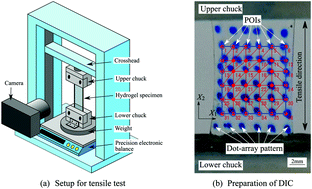Evaluation of the effects of cross-linking and swelling on the mechanical behaviors of hydrogels using the digital image correlation method
Abstract
Experimental evaluation and modeling are important steps in the investigation of the mechanical behaviors of hydrogels in the small- to large-strain range. In this study, the effects of cross-linking and swelling on the true stress–strain response of a specific type of hydrogel (polyacrylamide) were evaluated using a uniaxial tensile test. The development of true strain on the surface of the hydrogel was measured using the digital image correlation method. The specimens with higher cross-link density exhibited a higher initial elastic modulus and earlier orientation hardening. The initial elastic modulus was reduced by the swelling, whereas the orientation hardening occurred in an earlier strain range in the swollen hydrogel. The mechanical responses of the as-prepared and swollen hydrogels with different cross-linker contents were fitted using a non-Gaussian statistical model. The conventional model underestimated the decrease in the elasticity owing to the swelling effect and overestimated the increase in the stress in the large-strain range. The mechanical model was suitably modified to yield an accurate reproduction of the mechanical responses. The proposed model, which was characterized by five material parameters, was found to reproduce the characteristics of the mechanical responses of the as-prepared and swollen hydrogels with different cross-linker contents.



 Please wait while we load your content...
Please wait while we load your content...